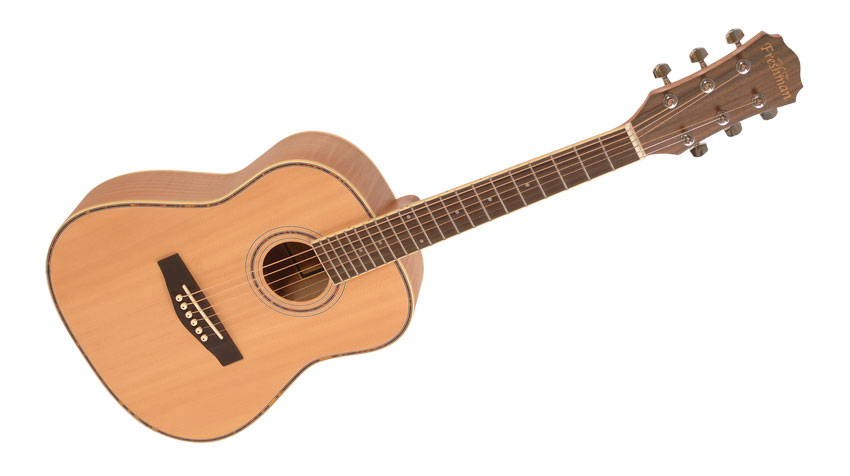MusicRadar Verdict
A good quality, practical and fun travel guitar, but you'll want to head back to a dreadnought for recording/performing purposes.
Pros
- +
Well-built and spec'd, especially considering the price.
Cons
- -
Small scale length. Not particularly loud.
MusicRadar's got your back
Life on the road is already cumbersome enough without a dreadnought in tow, and for that reason, travel guitars are more compact in every direction, from rim depth to soundboard width (and, perhaps even more importantly when it comes to performance, in the scale length from nut to bridge).
On first inspection of the FA1TRAVLTD, you may feel the overwhelming urge to play George Formby's When I'm Cleaning Windows. Technically, it's a dreadnought, but one that's apparently been zapped by a mad scientist's Shrink-o-Matic, and with such dinky dimensions, it's hard to imagine it'll turn in a serious performance.
That said, in terms of cost-per-gram, this pocket-sized £299 strummer is probably more expensive than gold or caviar. Could the FA1 be a more heavyweight choice than it seems?
The sense of novelty retracts a little when you examine an undeniably healthy spec. Peruse the body and you'll find an A-grade solid Sitka spruce top locked to an attractive flamed maple back by tortoiseshell binding: all very slick and professional.
"Full-sized dreads are bulky and make you work for your riffs; this one is so light and tight that it totally nails the travel element of the brief"
Peek inside the soundhole and you'll note proper bracing and a Fishman Sonitone GT1 whose two rollers control the undersaddle piezo. It turns out this isn't a joke guitar for house parties but a functional instrument.
It looks ridiculous on a strap, but when you first sit down with the FA1, you'll be in comfort heaven. Full-sized dreads are bulky and make you work for your riffs; this one is so light and tight that it totally nails the travel element of the brief.
The rim depth is only 86mm and the soundboard width just 317mm (compared to this writer's own dread, which clocks 116mm and 395mm), factors that mean it initially feels like an effortless, barbecue-friendly breeze. But compact size comes at a price.
"The FA1's raw tone is interesting, with plenty of snap and pop thanks to the treble-leaning combo of spruce and maple"
This reviewer doesn't have particularly big hands, but the teeny scale length means that fiddlier chord shapes and fingerstyle soon start to feel cluttered. The lack of cutaway is understandable, but does seem to underline the sense that this guitar doesn't give your fingers much room to run riot.
Sounds
The FA1's raw tone is interesting, with plenty of snap and pop thanks to the treble-leaning combo of spruce and maple. But, as you'd expect from such tiny internal dimensions, it doesn't have a lot of low-end warmth, and it's also not particularly loud, especially when you ditch the pick and give it a bit of Nick Drake.
You could argue that's what the piezo is there for, and it's certainly true that under amplification there's a lovely, glistening tone that can be fattened up to sound more substantial. But then, if you're having to cart an amp around with you, doesn't that somewhat negate the whole point of having such a lightweight guitar?
Don't get us wrong: Freshman's FA1 is a great laugh for a day at the beach and a breath of fresh air after having a dreadnought slumped on your lap. Still, we can't help thinking that if you're serious about acoustic performance and tone, you may soon outgrow it.
“The last thing Billy and I wanted to do was retread and say, ‘Hey, let’s do another Rebel Yell.’ We’ve already done that”: Guitar hero Steve Stevens lifts the lid on the new Billy Idol album
"This $399 item will incur over $578 in additional import charges": Price of Sonicware CyDrums drum machine more than doubles thanks to Trump tariffs
“For guitarists who crave an unrelenting, aggressive tone that stands out in any mix”: The Fortin Meshuggah head is the amp every metal player wants – now you can get its crushing tones in a pedal










